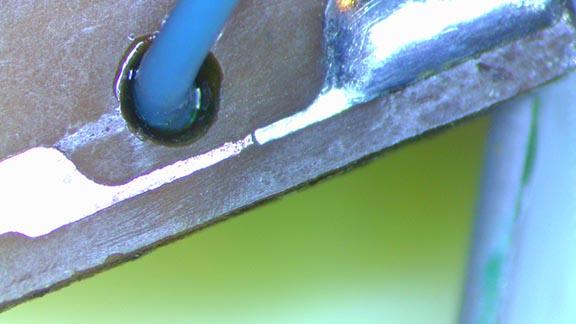- This topic has 17 replies, 4 voices, and was last updated 1 year, 9 months ago by
Mark-sf.
- AuthorPosts
- 5 May 2023 at 02:29 #46318
I have just had my ~1989 MMC4 re-worked / re-furbished, but having installed it no sound comes out of the LH channel. Except …
- When the needle drops I get _some_ sound on the LH channel for a _very_ brief moment, then silence.
- When I lift the needle, I get _some_ sound on the LH channel for, again, a _very_ short period, then silence (as the needle is no longer on the record).
Is this likely to be the turntable, the amp (Beomaster 5500), the DIN connections, or perhaps even the stylus? As I have only recently dug the system out of a box after years of storage, I didn’t check the stylus before I sent it off for repair. The rest of the system works fine on both channels.
TIA
EDITED TO ADD – according to this old thread it might be the muting relay. https://archivedforum.beoworld.org/forums/t/7055.aspx I have just changed the muting relay in the Beomaster 5500. Does anyone know if it is the same component, as I did order a “spare” relay last week.
5 May 2023 at 03:45 #46319There are four terminals coming out of the back of the muting “switch” – just below the “11” on the board; the lower pair show OL when the switch is “out”, and 0.2 Ω when in. The top pair show OL & 0.4-0.5 Ω. The leads themselves measure 0.2 Ω, so does that suggest that it is the top pair that are not making “perfect” contact (ie 0.2 – 0.2 = perfect, but 0.5-.02 isn’t)? Forgive me, but I am very new to all of this.
If I check the left hand (vertical) pair of contacts then the readings are OL & 0.3 Ω, and the right hand pair are OL & 0.2 Ω
In the other thread it suggests shorting the muting switch; how do I determine which contacts need shorting?
5 May 2023 at 05:06 #46320The muting switch shorts the signal to so your ohm readings are correct. What you need to measure is when the cartridge is plugged into the arm and the switch unmuted you should see around 800 ohms on both channels.
6 May 2023 at 03:07 #46321Thanks; with the MMC4 back in, I get the following resistances … but am not sure how to interpret them. Might I have some assistance?
I’m still not sure whether the channels are vertical or horizontal.
TIA
6 May 2023 at 04:52 #46322All fine so far.
The fact that you actually have sound from the affected channel, even if only briefly, suggests that the wiring is fine.
The problem could be with the cartridge itself.
I have seen cases where sound is lost when the needle is on a record.
Perhaps a dying cantilever suspension.
Do you have access to another cartridge for testing?Martin
6 May 2023 at 11:05 #46323Those do not look right. Measure the cartridge pins when it’s not installed. The pins are looking from the back:
L+. R+
L- R-
The 740 ohms should exist between L+ to L- and R+ to R-. There should be no resistance between R+ and L+.
7 May 2023 at 03:48 #46328I have just had my ~1989 MMC4 re-worked / re-furbished
Can you provide more details about this? Probably the most significant info is how was your cartridge was tested it before was returned.
All of the measurements of you cartridge appear to be correct. Are you sure that it is not something simple like not fully seating the cable between the turntable and the receiver?
Is the cartridge deflecting the right amount when you place it on the record? Have you measured the tracking force?
You may also want to look for other problem sources like cold solder joints and cracked traces.

Above is a picture of a cracked trace that was causing an bad connection. The crack was at the edge of the solder flux and was impossible to see until I removed the flux and cleaned the area with a scratch pen. Something like this could result in the symptoms that you are describing.
Glitch
7 May 2023 at 06:53 #46329Those do not look right. Measure the cartridge pins when it’s not installed. The pins are looking from the back: L+. R+ L- R- The 740 ohms should exist between L+ to L- and R+ to R-. There should be no resistance between R+ and L+.
Unmuted; When the cartridge is fitted to the arm, the two coils have their respective negative ends connected to signal ground. This means that if you measure from L+ to R+, you measure the two coils in series (2x 740 = 1480). All fine. Muted; All cartridge pins are connected to signal ground. All fine. Martin
Martin, I agree but the diagram is still wrong as a single pin cannot have 1480 and .2 ohms. It would be 1480 and 740 ohms.
7 May 2023 at 07:02 #46324Those do not look right. Measure the cartridge pins when it’s not installed. The pins are looking from the back: L+. R+ L- R- The 740 ohms should exist between L+ to L- and R+ to R-. There should be no resistance between R+ and L+.
Unmuted; When the cartridge is fitted to the arm, the two coils have their respective negative ends connected to signal ground.
This means that if you measure from L+ to R+, you measure the two coils in series (2x 740 = 1480).
All fine.Muted; All cartridge pins are connected to signal ground.
All fine.Martin
7 May 2023 at 10:08 #46325With the cartridge removed I get ~ 764 Ω on both channels, and OL across the other pin pairs. So combining both of the above two replies I think that a) the cartridge itself, b) the wiring to the mute switch and c) the mute switch itself are all doing what they should be doing.
Interestingly, with the power to the turntable removed, but the phono plugged in to the Beomaster, the mute switch _does_ mute / unmute the LH channel when I press on the lever with my fingers. Not sure if this matters or not, but when the mute switch is released (ie unmuted), I do get some additional hum from the LH channel if I touch the metal shielding on the switch body.
But with a record on I still only get the briefest of sound out of the LH channel when the stylus is lowered or raised.
7 May 2023 at 11:29 #46326Do you have access to another cartridge for testing?
Martin
7 May 2023 at 11:35 #46327I don’t have another, no. And they are sufficiently expensive that I am hesitant to want to buy one if possible
8 May 2023 at 06:44 #46330“Martin, I agree but the diagram is still wrong as a single pin cannot have 1480 and .2 ohms. It would be 1480 and 740 ohms.”
When muted all pins are connected. That’s where the 0,2-0,3 Ohms come in.
When unmuted, the L- and R- are still connected (signal ground), so when measuring between L+ and R+ you are measuring the two coils in series.
Their common center connection to ground doesn’t matter, seeing as you are not measuring with respect to ground.OP: Any access to another Beogram to test the suspect cartridge with?
Where are you based?Martin
8 May 2023 at 07:48 #46331When muted all pins are connected. That’s where the 0,2-0,3 Ohms come in. When unmuted, the L- and R- are still connected (signal ground), so when measuring between L+ and R+ you are measuring the two coils in series. Their common center connection to ground doesn’t matter, seeing as you are not measuring with respect to ground.
Martin, I was not commenting on the first diagram. It’s the second that is wrong. It should read
* 1480 *
740. 740
*. .0.2 *10 May 2023 at 04:10 #46332Many thanks for the replies. I’ll try to answer them in turn…
- The cartridge was re-furbished by a well known UK B&O specialist independent, who seem to be well regarded. Not sure if it is fair to identify him just now, but his diagnosis was “It is suitable for a rebuild / Coils good / Diamond heavily worn not suitable for suspension only / Suspension failed”, and so I went for a “Nude Elliptical Diamond, Aluminium cantilever”.
- The problem _could_ be a poor connection between the turntable and the amplifier, but why would it _always_ push sound through the LH channel at needle drop & needle rise only?
- The cartridge looks to deflect fine when it lands; the tracking force on the slider was cross checked with a stylus balance scale.
- Sadly I don’t have access to another Beogram.
- I am based in Sussex / UK.
- I can’t find a suitable external phono pre-amp to use with the Beogram and a Sonos ZP120 amplifier, but plugging the deck into the Sonos and raising the volume a _lot_ (due to no phono pre-amp), both channels seem to be at the same volume.
- If this last bit means that there is something wrong with the Beogram phono lead and/or the Beomaster 5500’s phono input, then what to test next? It does seem strange that the briefest of unmuting only happens at needle drop and needle raise though.
- I am awaiting receipt of an opto-reader for my MCP before I can try connecting the Beogram back up to the Beomaster – I will try the phono RCA inputs next – as the volume is too loud and I can’t at the moment reduce it (the MCCP will only raise the volume, not lower it !!!)
10 May 2023 at 04:30 #46333You could try setting the tracking force very low (0.2-0.3g) and see what happens.
The needle may not track correctly, and it may jump around a bit, but it would also
merely be to test if sound is produced from both channels.Another test could be to take off the cartridge and put it aside, start the Beogram (play)
without it and while it is “playing”, insert a small strand of copper wire into
the cartridge socket, one hole at a time, listening for a healthy buzz from the amp/speakers.
The L+ and R+ socket pins respectively, should give that if the deck, leads, amplifier and speakers are fine.Martin
10 May 2023 at 05:48 #46334The problem _could_ be a poor connection between the turntable and the amplifier, but why would it _always_ push sound through the LH channel at needle drop & needle rise only?
It is a long shot, but if there is a crack or loose connection then the tracking force (or tone arm angle change) might be enough to open it up.
Another possible test is to measure the resistance between the pins of each channel at the connector on the rear of the turntable. Each should start close to 0.0 ohms and jump to 740 ohms when the stylus drops and the muting relay opens. The reading should switch back to zero when you raise the stylus.
Glitch
10 May 2023 at 05:57 #46335The fact that you got both channels working albeit at a low level into the Sonos points to the Beomaster phono inputs. You stated you have the RCA DIN adapter. I would try that as it allows you to switch channels to see if the bad channel follows. If it does not then it’s a Beomaster problem.
- AuthorPosts
- You must be logged in to reply to this topic.





